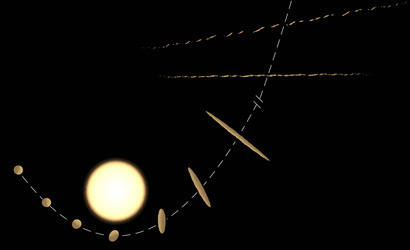New Theory Could Explain 'Oumuamua Interstellar Object With Huge Implications
A mysterious cigar-shaped interstellar visitor that has so-far stumped scientists could have been explained, with a new theory for how it could have formed – and debunking far-fetched speculation that it might be an alien probe. First sighted in late 2017, 'Oumuamua is the first known interstellar object in our solar system, leaving astronomers scratching their heads as to how something so unusual could have been created.
Named with the Hawaiian word for "a messenger from afar arriving first" by researchers at the Haleakala Observatory, 'Oumuamua is estimated to be between 330 and 3,280 feet long, and between 115 and 548 feet wide. Dark red in color, it has similar rotation to an asteroid, but its unusually elongated shape singles it out among other space debris.
Meanwhile the fact that it is tumbling, instead of rotating smoothly, and moving fast in relation to the Sun left scientists convinced that its origins lay outside of our own solar system. Despite speculation that it could be something alien in origin, however, the general consensus was that 'Oumuamua is of purely natural origin. Exactly what, though, was less easy to settle on.
That's something a new formation theory put forward by Yun Zhang at the National Astronomical Observatories of the Chinese Academy of Sciences and coauthor Douglas N. C. Lin at UC Santa Cruz believe they've answered. Using computer simulations to show how objects like 'Oumuamua might be created, they settled on tidal forces similar to those experienced by Earth's oceans.
If an object flies close enough to a star, their models revealed, it can be torn into "extremely elongated fragments" that then get ejected into interstellar space. Thermal modeling, meanwhile, helped explain why 'Oumuamua could keep its long, cigar-like shape. The surface of the fragments would melt when near to the star, and then condense again when further away. In the process it would give the object a cohesive crust, helping to maintain its stability.

As for the reddish color, that has an answer in the simulations too. "Heat diffusion during the stellar tidal disruption process also consumes large amounts of volatiles, which not only explains 'Oumuamua's surface colors and the absence of visible coma, but also elucidates the inferred dryness of the interstellar population," Zhang suggests.
High-sublimation-temperature volatiles, like water ice, could remain trapped under the rocky surface. Were that to outgas, it could act as a natural rocket, accelerating 'Oumuamua like a comet.
While perhaps not as exciting as aliens creating an interstellar probe, the new theory does indicate that 'Oumuamua would be by no means alone in the universe. Indeed there could be trillions of ejections, as everything from comets and debris disks, through to super-Earths, are reshaped through close encounters with stars. That might in turn have serious implications for theories about how life could be created.
One possibility is that some of these far-ranging travelers could be fast-moving incubators of life, with 'Oumuamua-like objects potentially picking up microorganisms or their chemical precursors while moving through habitable zones, and then distributing them elsewhere. Known as panspermia, the theory suggests life on planets can be seeded by microorganisms hitching a ride on interstellar traffic.
